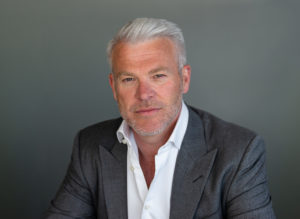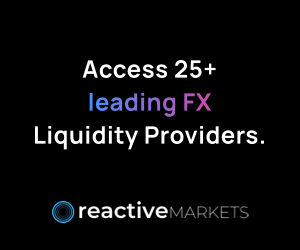The Full FX Conversation: Creating Change in Markets
Posted by Colin Lambert. Last updated: April 19, 2022
Colin Lambert talks to David Mercer, CEO of LMAX Group about conditions in FX and crypto markets – and effecting change in market structure
![]() Colin Lambert: Volatility is nothing new to crypto markets, but more recently FX markets have also been more volatile. What are your observations on how each has behaved, in market structure terms, over the first quarter?
Colin Lambert: Volatility is nothing new to crypto markets, but more recently FX markets have also been more volatile. What are your observations on how each has behaved, in market structure terms, over the first quarter?
![]() David Mercer: It’s been a surprise actually – none of us have traded a war in Europe involving one of the world’s largest energy producers, so we weren’t sure what to expect, but thought it would be whippy. In crypto especially, a lot of mining goes on in Russia, so we expected one of two things – a pandemic-like sell-off or a massive jump on a gold-like hedge.
David Mercer: It’s been a surprise actually – none of us have traded a war in Europe involving one of the world’s largest energy producers, so we weren’t sure what to expect, but thought it would be whippy. In crypto especially, a lot of mining goes on in Russia, so we expected one of two things – a pandemic-like sell-off or a massive jump on a gold-like hedge.
In reality we haven’t seen an over-reaction in crypto or FX markets. Volatility has been low and investors haven’t been all that shaken up by the war to this point. There has been a pricing in of more hawkish Fed policy, which has had a favourable impact on the US Dollar and this has also resulted in some weakness in crypto, but again, the reaction has been mild.
![]() That could be taken as a positive sign of the crypto market’s growing maturity as an asset class – it behaved largely in line with other assets?
That could be taken as a positive sign of the crypto market’s growing maturity as an asset class – it behaved largely in line with other assets?
![]() This is a resilient market, which means whoever is trading it can have confidence they are not going to get carried out completely – it charts, its trades a bit like the euro and the S&P, so they can put some capital in it. Bitcoin on its own has shown its resilience, it showed it in 2020 when the pandemic hit – yes, we saw a drop, but it recovered – and this year it has shown it again.
This is a resilient market, which means whoever is trading it can have confidence they are not going to get carried out completely – it charts, its trades a bit like the euro and the S&P, so they can put some capital in it. Bitcoin on its own has shown its resilience, it showed it in 2020 when the pandemic hit – yes, we saw a drop, but it recovered – and this year it has shown it again.
Sometimes people get too wrapped up in the debate. You don’t have to be a believer in crypto, it’s not important. People want to trade it because it moves and it’s a little different to other assets. Last year, it was the eighth biggest currency pair traded on our exchange. It’s growing, but we need to remember it remains a small market in terms of global capital markets.
![]() At various times, we have had crypto compared to a store of value (gold), a medium of exchange (currency) and more recently headline markets have followed equities. Is crypto still seeking its “identity”?
At various times, we have had crypto compared to a store of value (gold), a medium of exchange (currency) and more recently headline markets have followed equities. Is crypto still seeking its “identity”?
![]() It’s probably fair to say that, this is a relatively new asset class, but the evangelists would argue that crypto is very aware of its identity – it’s more a case of the markets figuring out exactly what that is. At a high level, crypto has become a risk on/off trade, we have seen downside pressure from risk-off flow in recent months, because there are still many market participants who believe Bitcoin to be an emerging asset.
It’s probably fair to say that, this is a relatively new asset class, but the evangelists would argue that crypto is very aware of its identity – it’s more a case of the markets figuring out exactly what that is. At a high level, crypto has become a risk on/off trade, we have seen downside pressure from risk-off flow in recent months, because there are still many market participants who believe Bitcoin to be an emerging asset.
I think the identity will be formed as the regulatory framework evolves and it’s not a binary outcome – there is a deal of complexity involved. I think regulators will look at the market and see Bitcoin as a currency – so outside a lot of financial regulation – and Ethereum as a security, which is very much in.

I think we helped create a little bit of change in FX markets, and we can do the same when it comes to how institutions look at crypto.
Then there are the Alt Coins which are developing new blockchains and so have to be investigated individually to a degree; and then there’s DeFi, which is another thing altogether. The regulators are trying to deal with Bitcoin and Ethereum, but there is so much more they have to deal with and understand – crypto assets are as diverse as other assets.
On the subject of regulation, crypto evangelists want to write their own framework but they need to wise up. There are distinct products and there is a well-trodden path to regulation for each. If it looks and feels like a security, for example – use the existing regulatory framework, because it works.
![]() In related terms then, does it need to build its own market dynamic, rather than be compared to existing TradFi asset classes?
In related terms then, does it need to build its own market dynamic, rather than be compared to existing TradFi asset classes?
![]() Yes, but we think we’re still early here. We’re only just starting to see the arrival of institutional players and major banks. As adoption continues on this scale, we should then see the materialisation of an asset class with its own market dynamics. Partnerships like the one LMAX Group and SIX have created to launch CCP cleared crypto futures are the types of partnerships that will get us there.
Yes, but we think we’re still early here. We’re only just starting to see the arrival of institutional players and major banks. As adoption continues on this scale, we should then see the materialisation of an asset class with its own market dynamics. Partnerships like the one LMAX Group and SIX have created to launch CCP cleared crypto futures are the types of partnerships that will get us there.
![]() You mentioned DeFi. Isn’t there a challenge there though, that it may not work for institutions like the big asset managers? Most markets that these firms trade are centralised at some point, DeFi doesn’t necessarily work for them because it’s a potential nightmare for compliance.
You mentioned DeFi. Isn’t there a challenge there though, that it may not work for institutions like the big asset managers? Most markets that these firms trade are centralised at some point, DeFi doesn’t necessarily work for them because it’s a potential nightmare for compliance.
![]() At the moment the world is still coming to terms with how the crypto world works and what decentralised finance really is. It makes total sense as a proposition but can it be scaled?
At the moment the world is still coming to terms with how the crypto world works and what decentralised finance really is. It makes total sense as a proposition but can it be scaled?
I think we’ll end up with an institutional CEX – a centralised exchange – interacting with all the DEXs. If you look at the markets that you and I are involved in, DeFi just cannot be a part of it over the next decade, but let’s go forward in bite sized chunks, let’s work on what we can change. We agree that bitcoin is a currency and trades like one, and that other coins are like securities. We also believe in the tokenisation of everything, so let’s fit those things into the regulatory framework – that is achievable.
Once done we can bring it to the market, people want to be able to access these markets through trusted mechanisms like LMAX Group, not have to open accounts on obscure sites that could be based anywhere. We want to provide total market access.
![]() How does crypto evolve from here, and with volatility – and presumably returns – back in traditional asset classes, how attractive will it be to the institutional investor community?
How does crypto evolve from here, and with volatility – and presumably returns – back in traditional asset classes, how attractive will it be to the institutional investor community?
![]() For now, this is mostly about Bitcoin rather than crypto on a broad basis. Bitcoin is the asset being used as an alternative investment and portfolio diversifier. Ultimately, as central banks are forced to normalise monetary policy in response to rapidly rising inflation, it will further increase investors’ appetite to get exposure to this asset class.
For now, this is mostly about Bitcoin rather than crypto on a broad basis. Bitcoin is the asset being used as an alternative investment and portfolio diversifier. Ultimately, as central banks are forced to normalise monetary policy in response to rapidly rising inflation, it will further increase investors’ appetite to get exposure to this asset class.
We see this pushing crypto further into the spotlight and helping to drive more adoption amongst traditional market participants.
On the institutionalisation question, we need to remember it’s a process and it will take time. I’m not talking institutionalisation this year, for me, crypto won’t be institutionalised until the big bulge bracket banks are trading it for their big customers and themselves.
It’s OK to say institutionalisation is coming, but it’s incremental. At the moment it’s probably form over substance, the institutions are forming their teams and getting into price discovery and talking with their regulator, but they’re not doing much else today. That will change though.
![]() What role will LMAX Group play in this process?
What role will LMAX Group play in this process?
![]() The cash market is suffering from a lack of regulation, the institutions’ risk committees need to see that framework before they allow the firm to trade it. We need to be pragmatic and deliver a structure these people understand and want, and work with the people on the desks. This is why we launched futures, institutions can have their economic interest in crypto, because it’s a dollar-settled derivative. The bank can say they are in crypto, but they’re not touching the blockchain and the coin.
The cash market is suffering from a lack of regulation, the institutions’ risk committees need to see that framework before they allow the firm to trade it. We need to be pragmatic and deliver a structure these people understand and want, and work with the people on the desks. This is why we launched futures, institutions can have their economic interest in crypto, because it’s a dollar-settled derivative. The bank can say they are in crypto, but they’re not touching the blockchain and the coin.
![]() But for these firms to really get involved, crypto needs to be about more than HODL surely? They need to know that volumes and business levels will be enough to sustain the level of investment they would have to put into the business.
But for these firms to really get involved, crypto needs to be about more than HODL surely? They need to know that volumes and business levels will be enough to sustain the level of investment they would have to put into the business.
![]() Fair enough, but if just a couple of percent of assets under management go into crypto, the price has to go up – it’s the basics of economics, so HODLing has its place. The market cap of gold is between $10 and 15 trillion, if we are talking about crypto in three-to-five years, it has to be in that range if we’re still to be talking about it. That would make crypto credible and I believe it will get there.
Fair enough, but if just a couple of percent of assets under management go into crypto, the price has to go up – it’s the basics of economics, so HODLing has its place. The market cap of gold is between $10 and 15 trillion, if we are talking about crypto in three-to-five years, it has to be in that range if we’re still to be talking about it. That would make crypto credible and I believe it will get there.
There also needs to be structural change. These firms need real strategies and real use cases for crypto. Bitcoin can become useful, but it isn’t today, so it’s an investment process. Today, we settle on a Saturday and Sunday for Bitcoin, in dollars – that’s hugely powerful for capital markets, but firms will need to change to adopt. The good news is that they are already investigating that change.
![]() So again, you’re challenging the status quo in markets?
So again, you’re challenging the status quo in markets?
![]() I think we helped create a little bit of change in FX markets, and we can do the same when it comes to how institutions look at crypto. By launching LMAX Digital when we did, it woke up the institutions, they wanted to know how we were doing it and it started conversations.
I think we helped create a little bit of change in FX markets, and we can do the same when it comes to how institutions look at crypto. By launching LMAX Digital when we did, it woke up the institutions, they wanted to know how we were doing it and it started conversations.
It’s the same thing with our new crypto futures, we’re breaking new ground for our clients, but we need to do it in partnership – everyone needs to do their bit. The banks need to become custodians; a clearing house like SIX needs to do its bit for the legitimisation. Other banks need to offer trading – and I think Goldman Sachs doing the NDF trade was a big moment – which means we’re all playing a role in helping the ecosystem. That also creates opportunity for everyone, including us, because for the wider market to benefit, we need a better ecosystem.
![]() How big can crypto, or the digital assets space more broadly, become? What do you think are the most exciting areas for market participants?
How big can crypto, or the digital assets space more broadly, become? What do you think are the most exciting areas for market participants?
![]() We live in a digital world and the business of digital assets is growing at a rapid pace. Whether it be solutions around accessibility, cost, transfer speed and settlement, or advantages to Web3 economics such as DeFi, NFTs and DAOs, the compelling use cases for cryptocurrencies have become clearer.
We live in a digital world and the business of digital assets is growing at a rapid pace. Whether it be solutions around accessibility, cost, transfer speed and settlement, or advantages to Web3 economics such as DeFi, NFTs and DAOs, the compelling use cases for cryptocurrencies have become clearer.
This should propel the market over the coming years. As far as size goes, we believe crypto assets should scale to the levels of other major financial instruments and that bitcoin will surpass gold in market size over the next few years.
To do that, however, we need a degree of collaboration, something that is not natural to participants in traditional markets. That said, the digital world is a little different – and that‘s another challenge to the institutions – and crypto natives do help each other, they share ideas and build more of a community.
Just to reiterate, it is a process and it will take time, but our launch of crypto futures highlights a big step forward, and that’s reflected in the uniformly good feedback we have had from banks and non-banks about the launch.




